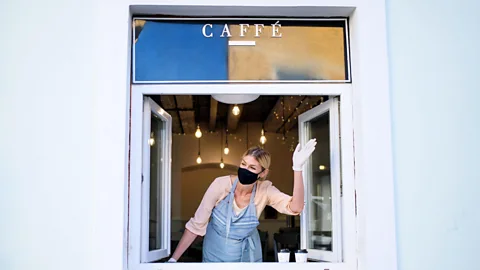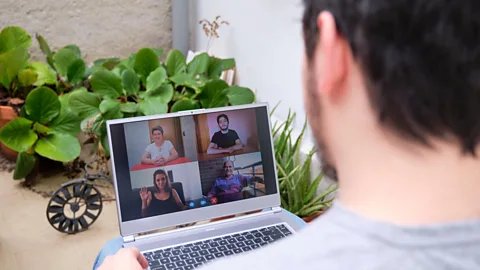Why your ‘weak-tie’ friendships may mean more than you think
 Alamy
AlamyClose friends are important – but research shows that building networks of casual acquaintances can boost happiness, knowledge and a sense of belonging.
As we head into 2021, Worklife is running our best, most insightful and most essential stories from 2020. Read our full list of the year’s top stories here.
For nearly 10 years, I have spent my Monday evenings attending rehearsals for my amateur choir. Mondays are not my favourite day, and I often arrive in a bad mood, but by the end of the rehearsal, I usually feel energised. The singing does me good. So do the people. With a few exceptions, I wouldn’t describe my fellow choir members as close friends; most of them, I barely know at all. We exchange brief chats, smiles and the odd joke – but that’s enough for me to come away feeling a little better about the world.
There is no choir practice now, and won’t be for a long time. I miss it. In lockdown, I don’t feel short on affection or emotional support, but I do feel short of friendly faces and casual conversations. Another way of putting this is that I miss my weak ties.
In 1973, Mark Granovetter, a sociology professor at Stanford University, published a paper entitled The Strength of Weak Ties. It went on to become one of the most influential sociology papers of all time. Until then scholars had assumed that an individual’s well-being depended mainly on the quality of relationships with close friends and family. Granovetter showed that quantity matters, too.
One way to think about any person’s social world is that you have an inner circle of people whom you often talk to and feel close with, and an outer circle of acquaintances whom you see infrequently or fleetingly. Granovetter named these categories “strong ties” and “weak ties”. His central insight was that for new information and ideas, weak ties are more important to us than strong ones.
Granovetter surveyed 282 Boston-based workers and found that most of them got their jobs through someone they knew. But only a minority got the job through a close friend; 84% got their job through those weak-tie relationships – meaning casual contacts whom they saw only occasionally. As Granovetter pointed out, the people whom you spend a lot of time with swim in the same pool of information as you do. We depend on friendly outsiders to bring us news of opportunities from beyond our immediate circles – and so the more of those acquaintances we have, the better.
 Alamy
AlamyThe coronavirus pandemic may have a direct impact on people’s weak ties, and the benefits they reap from them. Companies that have been forced to change working practices by the crisis may end up making a permanent shift toward home-working and virtual workspaces. Although workers stand to benefit in many ways, including increased flexibility, one possible downside of this change is that it shrinks our social networks.
Physical offices enable not only formal face-to-face meetings, but they also function as spaces for chance encounters with our professional weak ties – in other words, people with whom we do not work closely but whose work has an impact on our own.
Some companies specifically design their offices in order to generate serendipitous meetings among employees from different departments. This was the idea behind the Pixar building, the design of which was overseen by Steve Jobs. The building has a large central hall through which all employees have to pass several times a day. Jobs wanted colleagues to bump into each other, grab coffee and shoot the breeze. He believed in the power of these seemingly random conversations to fire up creativity.
Encounters with weak ties can be good for our mental wellbeing, too. When Gillian Sandstrom was living in Toronto as a graduate student in psychology, she often had to walk between two university buildings, passing a hotdog stand on the way. “I’d always smile and say hi to the hotdog lady," she says. "We never even had a conversation, but I felt recognised, I felt connected – and that made me feel good.”
That episode inspired Sandstrom, now a senior lecturer in psychology at the University of Essex, to investigate the extent to which people derive happiness from weak-tie relationships. She asked a group of respondents to keep a record of all their social interactions over the course of several different days. She found that participants with larger networks of weak ties tended to be happier overall, and that on days when a participant had a greater number of casual interactions with weak ties – say, a local barista, a neighbour, a member of yoga class – they experienced more happiness and a greater sense of belonging.
 Alamy
AlamyLockdown is making such encounters rarer for all of us. Weak-tie interactions happen when we are out and about, particularly when we’re taking part in an activity of some kind, like singing or cycling. A 2016 study, for which psychologists recruited respondents from Italy and Scotland, showed that regardless of nationality or age, people who were members of groups such as sports teams or church communities enjoyed an increased sense of meaning and security. And the more groups of which they were members, the better.
Right now, most clubs and communal groups are banned from holding events, and may not be able to resume for a while. We’re not regularly strolling down busy streets or bumping into people in cafés and bars. That means we’re missing out on low-cost, low-stakes conversations. “Sometimes it’s harder to talk to people we know well because those conversations come with an emotional burden,” says Sandstrom. “Weak-tie conversations are lighter and less demanding.”
They are also a source of novelty, at a time when the days can all feel the same. Sandstrom shared a story about a colleague who has a weekly video chat with her family. “She says they’re running out of things to say, because nobody’s doing anything right now.”
As Granovetter’s work showed, we get much of our new information from weak ties. That provides stimulation but also, in a time of uncertainty, guidance on how to behave. For instance, by engaging in a wide variety of conversations with weak ties, people can learn about how to cope with the various difficulties of life under lockdown.
 Alamy
AlamyFor all these reasons, we should continue to try and find ways to cultivate weak-tie relationships, in lockdown and beyond. Even under conditions of social distancing, our more distant friends are important to us. “We’re all curious to see how others are coping, what they’re doing, to help us figure out how to behave,” says Sandstrom.
Social media, she points out, is a useful substitute for weak-tie conversations. We can use it to reach out to people we don’t know well for light, but meaningful interactions. She adds that we can also engage in more weak-tie-style interactions with our strong ties, checking to see how people are without engaging them in a full conversation. The goal, says Sandstrom, is to let others know you are thinking of them without asking for a great deal of time, energy or attention.
After this pandemic has passed we should take care to rebuild our networks of casual acquaintances. We can learn a lot from talking to people we barely know.
